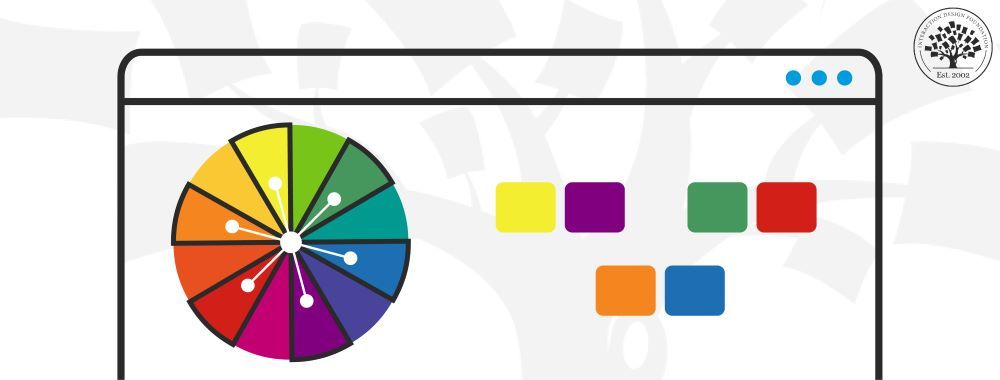Understand Color Symbolism

- 726 shares
- 5 mths ago
Color symbolism is the subjective meaning humans attach to various colors. People respond to color in three ways—biologically (e.g., red = fear), culturally (e.g., red = wellbeing in many Eastern societies) and personally from experience. Designers use color symbolism in (e.g.) logos to gain users’ trust and attention.
“Depending on context, colour can convey meaning often more effectively than words.”
— Zena O’Connor, Ph.D. in human responses to color, who established Design Research Associates
See why color symbolism matters greatly in design.
Color is a powerful tool for evoking emotions, expressing thoughts and communicating with—and persuading—your users, but its symbolism is subjective and depends on the context. How humans react to color is complex, stemming from our:
Biological response: For example, the color red can inspire fear and sexual desire, while blue light can help psychologically.
Cultural response: Different cultures value certain colors differently. Western societies typically esteem blue well above yellow; Eastern ones tend to prize yellow and see red without alarming or erotic overtones.
Personal associations with color: Our experiences can color our view of certain colors—e.g., someone’s childhood skiing accident might permanently scar their appreciation of white.
When designing, you can conjure a multitude of meanings through your color choices. Brand logos and colors need to resonate with the target audiences. So, industry and global market location are among the factors designers consider for leveraging color symbolism according to widely accepted associations, notably these:
© Daniel Skrok and Interaction Design Foundation, CC BY-SA 3.0
Red = Love, Passion, Strength, Power, Danger, Excitement, Energy
© Daniel Skrok and Interaction Design Foundation, CC BY-SA 3.0
Orange = Warmth, Creativity, Adventure, Freshness, Happiness, Attraction, Success
© Daniel Skrok and Interaction Design Foundation, CC BY-SA 3.0
Yellow = Optimism, Cheer, Happiness, Warmth, Caution, Energy, Intellect
© Daniel Skrok and Interaction Design Foundation, CC BY-SA 3.0
Green = Nature, Growth, Wealth, Luck, Envy, Freshness, Quality
© Daniel Skrok and Interaction Design Foundation, CC BY-SA 3.0
Blue = Trust, Calm, Sadness, Peace, Loyalty, Depth, Authenticity
© Daniel Skrok and Interaction Design Foundation, CC BY-SA 3.0
Purple = Royalty, Nobility, Wisdom, Luxury, Imagination, Mystery, Spirituality
© Daniel Skrok and Interaction Design Foundation, CC BY-SA 3.0
White = Purity, Simplicity, Innocence, Peace, Cleanliness, Emptiness, Goodness
© Daniel Skrok and Interaction Design Foundation, CC BY-SA 3.0
Black = Sophistication, Formality, Sorrow, Boldness, Elegance, Death, Mystery
© Pixabay and Pexels, CC BY-SA 3.0
Remember, context is key. And, while most “facts” about color psychology lack scientific basis, a deeper look at the palette can reveal some essential insights:
Red – Scarlet and crimson are among the variations that make red sexy and dangerous to Western eyes. Red may be bloody and arresting in the form of revolutionary rage and wounded bank balances, but red’s far less dramatic to Eastern eyes.
Orange – Linked with creativity and happiness, orange declares national and religious identity and defines athletic applications. Like red, it can grab attention (e.g., prisoner jumpsuits). Consider it for youthful, energetic brands as opposed to luxury, traditional or serious ones.
Yellow – The color of the Sun highlights with eye-catching warmth. Yellow can represent happiness, warmth, alarm, sickness, cowardice; take your pick. Some shades can look cheap, though, so it’s a noteworthy example of the need to research users’/customers’ reactions.
Green – It’s the color of Mother Nature and her life-sustaining bounty, with connotations of recycling and healthy finances. Green also means “proceed”; but there’s also inexperience and envy. The shade matters. Brighter, lighter greens indicate growth, vitality and renewal; darker, richer greens represent prestige, wealth and abundance.
Blue – People find blue trustworthy, assuring, calming and masculine. It’s a tranquil sea and peaceful wonder at the sky; but then it can “mood-swing” to depression. You can bank on blue for designing financial and corporate dependability, although the right shade is vital.
Purple – Long associated with royalty, purple connotes luxury and indulgence. But its majesty doesn’t always translate to design; for example, only women favor it as a top-tier color. Purple is uncommon in branding.
White – Cleanliness, goodness, innocence and simplicity are all associated with white. It’s as pure as a fresh snowfall, yet it signifies mourning in the East and means surrender internationally. Although innately positive, white lacks a dynamic personality, so it’s best left for brands that are indeed pure, simple and transparent.
Black – Black means serious business, with overtones of severity and mystery, of death and grief. However, its inherent darkness doesn’t always convey negativity. It’s also a positive bank balance and smart, attractive clothing. It’s best to consider contrasting it with a bright color: gold for luxury or white for a bold, simple statement. Also, its texture and glossiness can influence your brand’s message.
Lastly, the colors you choose need to match your users and their sensibilities, not your personal preferences.
A notable example of the application of color symbolism is the icons for The Global Goals. This project, undertaken by designer Jakob Trollbäck, head of Trollbäck + Company, made the old Sustainable Development Goals for eliminating world hunger, etc., more universally resonating. The highly symbolic designs and palette carefully consider cross-cultural relevance and serve as part of the hopeful language to inspire everyone, everywhere to act for improvements and equality in the lives of people across the planet.
© Jakob Trollbäck and The Global Goals, Fair-use
Take our Visual Design course.
Find some great tips and examples here.
This Canva piece insightfully explores color symbolism.
Colors are the most vital aspects of visual art and can often be more effective than words. Color symbolism in art means the usage of color as a symbol. Artists aim to draw attention, evoke specific emotions, or convey symbolic meanings by strategically using color and color modes. Different cultures and societies have cultural associations and symbolic significance to colors. Artists leverage these associations to enhance the depth and impact of their artwork.
Here are some common meanings of different colors in many Western cultures:
🔴Red: Passion, Love, Anger
🔵Blue: Calm, Strength, Trust
🟡Yellow: Happiness, Hope, Deceit
🟢Green: New Beginnings, Abundance, Peace
🟠Orange: Energy, Happiness, Vitality
🟣Purple: Creativity, Royalty, Wealth
⚫Black: Mystery, Elegance, Power
⚪White: Purity, Cleanliness, Virtue
🟤Brown: Warmth, Wholesomeness, Dependability
This video explains why we see and react to colors like we do. It shows how color affects our understanding and choices, making it easier to navigate the world.
In many cultures, white symbolizes purity, cleanliness, or innocence. In addition, the color white often embodies several other personalities and concepts. Since color meanings vary from culture to culture, white can have positive and negative connotations. For some, white can convey new beginnings, freshness, or simplicity. For others, white can seem too cold, sterile, and isolated.
Understand Color Symbolism in this article to discover all the personality traits of white and other colors.
As explained in Color Symbolism, people find blue trustworthy, assuring, calming, and masculine. It is the color of the ocean and the sky. Hence, they associate it with open spaces, freedom, intuition, imagination, inspiration, and sensitivity. However, the meaning of blue varies depending on the shade and hue. For instance, light blues are calming and relaxed. Dark blues like navy represent strength and reliability. Bright blues can be energizing and refreshing. Understand the transitory nature of color and how our perceptions of color can shift under different lighting conditions and surroundings in this video.
The symbolism of black color runs far and wide. In some cultures, it associates itself with darkness, heaviness, depression, death, mourning, and evil magic. In others, it can also symbolize elegance, wealth, and power. Black is also called “A color of many sentiments” due to the contrasting feelings it elicits.
Another fact about this color is that people often misunderstand black and associate it with sadness. However, far more than a depressing color, black is also powerful, striking, and a source of protection.
Green is a calming color. It has strong associations with nature and brings trees, forests, and lush grass to mind. Like all colors, different shades and hues of green have different meanings and evoke different emotions.
Bright Green: Rebirth, Spring
Yellowish Green: Illness, Envy, Decay
Aqua: Cleanliness, Freshness, Water
Pale Green: Peace
Olive Green: Tranquility, Earthiness, Elegance
Dark Green: Fertility, Greed, Money, Drive
The most common feelings that red can stimulate are danger, excitement, aggression, dominance, and passion. Red is the warmest and most contradictory color associated with positive and negative emotions. It has more opposing emotional associations than any other color.
Red has contrasting meanings around the world. In the West, red evokes excitement, danger, urgency, and love. When combined with green, the color scheme becomes festive. In China, India, and other Asian countries, it symbolizes happiness and good fortune.
The four primary colors in color theory are: red, yellow, blue, and green.
🔴Red is an intense color associated with physical aptitude.
🟡Yellow is a potent emotional stimulator that inspires positive thinking and confidence.
🔵Blue is a calming color that inspires clarity of thought and serenity.
🟢Green facilitates the harmony between the other chromes: red, yellow, and blue.
Always remember colors are subjective and use them in the right context. The article Use Color to Prevent Confusion and Help Your Users will help you learn the meaning of color and the importance of context.
Red, also called the color of love, represents love and passion. There are several reasons for this symbolism. The color red connects with the heart. A bright red icon ❤️ symbolizes the heart. This link contributes to red being a powerful symbol of love. In addition, the Greeks and Hebrews saw red as a sign of love. Lastly, because of its link with desire and passion, red is the color of love.
This course on Visual Design: The Ultimate Guide can help you strengthen your foundations of visual design. You’ll learn to use the right colors, type, visual design elements, and all the secrets to create a good design. You’ll also learn the significance of visual design, understand the impact of history on the present, and uncover practical ways to enhance your own work. You can also watch this brief video to learn “What is Color?”
Remember, the more you learn about design, the more you make yourself valuable.
Improve your UX / UI Design skills and grow your career! Join IxDF now!
You earned your gift with a perfect score! Let us send it to you.
We've emailed your gift to name@email.com.
Improve your UX / UI Design skills and grow your career! Join IxDF now!
Here's the entire UX literature on Color Symbolism by the Interaction Design Foundation, collated in one place:
Take a deep dive into Color Symbolism with our course Visual Design: The Ultimate Guide .
Master complex skills effortlessly with proven best practices and toolkits directly from the world's top design experts. Meet your experts for this course:
Mia Cinelli: Associate Professor of Art Studio and Digital Design at the University of Kentucky.
Joann Eckstut: Color Consultant, Founder of The Roomworks, and one of the 12 designers chosen by the Color Association of the USA to create the yearly forecast used by industries to keep up with color trends.
Arielle Eckstut: Author, Agent-at-large at the Levine Greenberg Rostan Literary Agency, and Co-Founder of The Book Doctors and LittleMissMatched.


We believe in Open Access and the democratization of knowledge. Unfortunately, world-class educational materials such as this page are normally hidden behind paywalls or in expensive textbooks.
If you want this to change, , link to us, or join us to help us democratize design knowledge!
